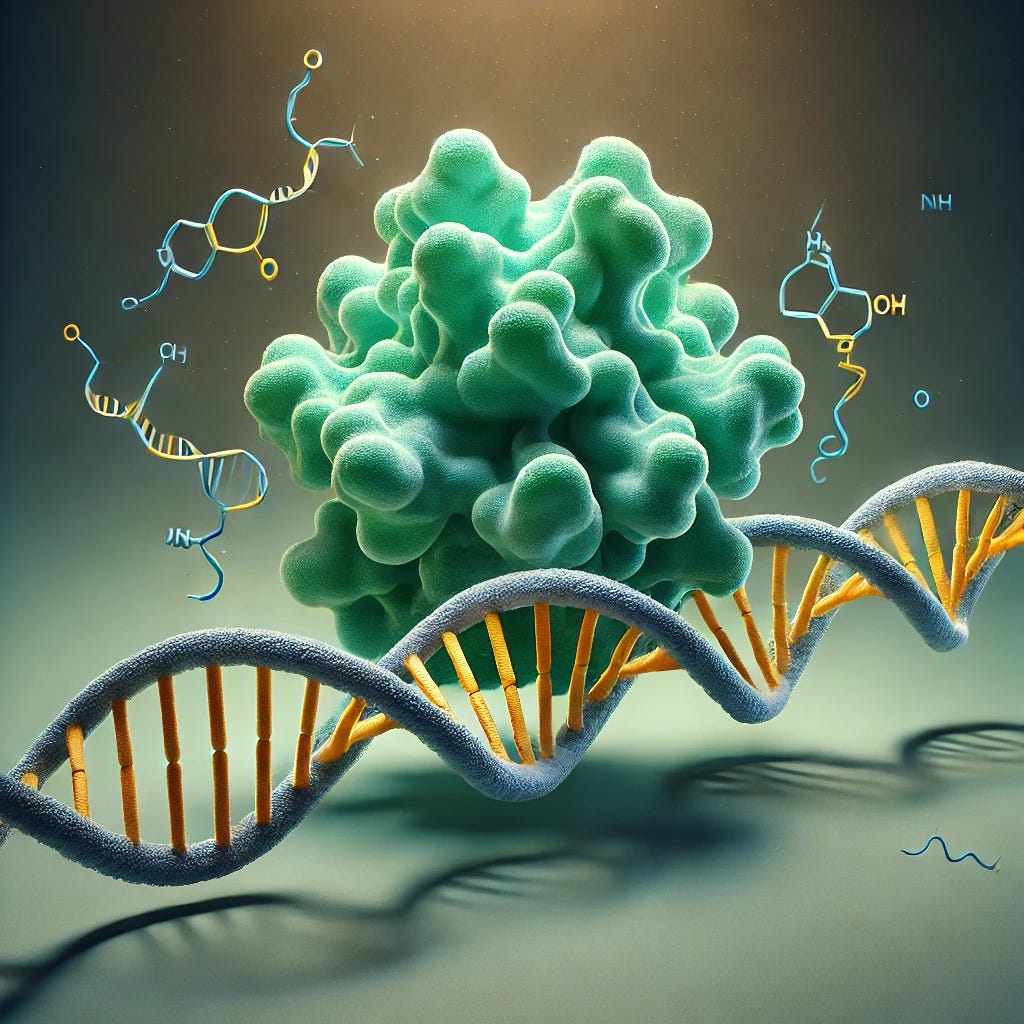Happy Tuesday Evening, Readers. Let’s be relentless this week!
I have the following interesting pieces to highlight from the land of biotechnology:
Obesity Drug Appears to Reduce Risk of Overdose in Patients with Opioid Use Disorder
Newborn Genome Sequencing for Early Actionable Conditions
Intellia’s One-Time Gene Editing Therapy NTLA-2002 Shows Promising Results for Hereditary Angioedema
RNA Editing Is A New Way to Treat Genetic Diseases
Obesity Drug Appears to Reduce Risk of Overdose in Patients with Opioid Use Disorder
GLP-1 receptor agonists like semaglutide and tirzepatide were originally developed from type-II diabetes treatments. Interestingly, over the past year, they have become the best-selling class of drugs, thanks to their remarkable efficacy for weight loss. Their success in treating obesity and diabetes has fueled my fascination, as they seem to do more than just aid in weight reduction. Mechanistically, these drugs simulate the hormone glucagon-like peptide 1 (GLP-1), which helps to manage blood sugar and appetite. Yet, beyond these effects, there have been some unexpected anecdotes surrounding these medications.
Many individuals on GLP-1 drugs report newfound clarity in decision-making, leading them to make life changes they've previously postponed—like changing jobs, ending relationships, or relocating. This has led me to a hypothesis that GLP-1 receptor agonists may reduce the "activation energy" required for these decisions, possibly by impacting dopamine management in the brain and altering reward systems (Eren et al., 2021). Considering this, I wondered: could these drugs also help people with substance use disorders, like opioid addiction, where behavioral control plays a huge role?
I recently stumbled upon a study that explored this potential and found that semaglutide (the key ingredient of Ozempic), specifically, may offer protective effects against opioid overdose in patients with both Type 2 diabetes (T2D) and opioid use disorder (OUD) (Wang et al, 2024). Drawing from a vast dataset of over 33,000 patients, researchers compared individuals prescribed semaglutide with those on various other antidiabetic medications, including insulin, metformin, and other GLP-1 receptor agonists like liraglutide and dulaglutide. The results showed that patients on semaglutide exhibited a reduced risk of opioid overdose across a one-year follow-up. Notably, the protective effect was strongest when semaglutide was compared to insulin, metformin, and other GLP-1 RAs.

The findings provide further evidence of a potential mechanism at play where semaglutide modulates reward pathways linked to dopamine, reducing the cravings associated with opioid use. This data agrees with prior evidence suggesting semaglutide acts on reward signaling in the brain, also observed in studies related to alcohol and nicotine (Chuong et al., 2023). It’s clear why this matters—imagine the potential for these drugs to support individuals with substance use disorders or even other psychological conditions. This is particularly relevant to the ongoing opioid epidemic, which continues to claim lives across the United States, but could also extend to other addiction issues. These insights underscore the importance of randomized clinical trials to explore the potential role of GLP-1 receptor agonists in addiction treatment.
Newborn Genome Sequencing for Early Actionable Conditions
Personalized medicine represents the next major leap in healthcare. DNA sequencing, in particular, offers a profound look into our genetic blueprints, highlighting heritable diseases and potential risk factors for others. Yet, for many—including myself—the privacy implications create a sense of hesitation (23andme data leak). Despite these concerns, a growing number of people are opting for sequencing, and private programs are increasingly tailoring health strategies based on DNA information, even from early ages.
In line with this, a recent study published in JAMA explores the feasibility of adding genome sequencing to traditional newborn screening (NBS) to identify a broader range of treatable conditions in infants, including those that lack detectable biomarkers in blood (Ziegler et al., 2024). This initiative, part of the Genomic Uniform-screening Against Rare Disease in All Newborns (GUARDIAN) study, targets over 100,000 infants, with preliminary results from the first 4,000 newborns indicating promising feasibility and outcomes.
This New York City-based study analyzed genetic markers linked to 156 early-onset conditions with proven interventions, along with 99 neurodevelopmental disorders associated with seizures. Notably, 72% of approached families consented to participate, suggesting that for most, the potential health benefits outweighed privacy concerns.
The study’s findings revealed a 3.7% positive screen rate, identifying treatable conditions not currently detected by standard NBS, such as glucose-6-phosphate dehydrogenase (G6PD) deficiency, long QT syndrome, and early cases of severe combined immunodeficiency (SCID). This expanded screening offers a pathway to early intervention for conditions that may otherwise go undiagnosed until symptoms emerge. Overall, The GUARDIAN study showcases genome sequencing's potential to broaden the scope of newborn screening and a proactive approach to treating genetic disorders from the onset.
Intellia’s One-Time Gene Editing Therapy NTLA-2002 Shows Promising Results for Hereditary Angioedema
Precise gene editing technologies like CRISPR allow scientists to specifically target and modify genes, and many believe these technologies could be the key to curing a range of genetic diseases. But how do they work? At a high level, the CRISPR-Cas9 system enables researchers to "cut" DNA at precise locations, allowing them to deactivate, alter, or repair genes responsible for a disease. Intellia Therapeutics is a company at the forefront of efforts to commercialize this technology for therapeutic use.
Intellia has developed a CRISPR-based therapy, NTLA-2002, to target the KLKB1 gene, which encodes kallikrein, a protein that plays a role in hereditary angioedema (HAE) attacks. HAE is a rare genetic disorder characterized by recurrent and often unpredictable swelling attacks that can be life-threatening. NTLA-2002 aims to offer a one-time treatment that could provide a permanent solution for HAE, potentially eliminating the need for continuous therapy.
The Phase 2 study results have been promising. Patients who received a single 50 mg dose experienced a placebo-adjusted reduction in monthly attack rates of 77% in the first 16 weeks, with reductions reaching 81% in the later weeks. Even more compelling, eight of the 11 patients in the 50 mg group were completely attack-free through the latest follow-up, with no need for further treatment. This efficacy rivals, if not surpasses, other available therapies, such as Ionis’s donidalorsen, which requires monthly injections. The competitive edge of NTLA-2002 lies in its one-time administration (Phase II Press Release).
The treatment has also shown a favorable safety profile. The most common side effects were mild, including fatigue and infusion-related reactions, with no serious or dose-limiting adverse events reported. This strong safety and efficacy profile reinforces NTLA-2002’s potential as a functional cure for HAE, and Intellia is now advancing the 50 mg dose into the global Phase 3 HAELO trial, with hopes to secure regulatory approval by 2026.
RNA Editing Is A New Way to Treat Genetic Diseases
Imagine being able to fix errors in the body’s genetic instructions—without making permanent changes to DNA. That’s the promise of RNA editing, a new approach in genetic medicine that’s gaining momentum. Unlike DNA editing tools, which alter the DNA permanently, RNA editing changes temporary copies of genetic instructions, called messenger RNA (mRNA). This allows doctors to adjust treatments or stop them if needed, making it more like traditional medicine than permanent gene editing.
Recently, researchers achieved a major milestone in this field. Wave Life Sciences, a biotech company, reported success in using RNA editing to treat a genetic disorder called alpha-1 antitrypsin (AAT) deficiency. This disease causes lung and liver problems due to a faulty protein. In their study, Wave’s therapy helped two patients produce more than 60% of the correct, healthy version of the AAT protein after just one dose. The effects lasted for nearly two months, showing that RNA editing could offer a lasting, yet adjustable, treatment option.
Many scientists see this breakthrough as a proof of concept that RNA editing can work for other conditions too. Other companies are now exploring RNA editing for various diseases, from inherited eye disorders to certain types of cancer. The technology often uses a method called A-to-I editing, where specific “letters” in the mRNA are changed to correct the genetic message. Another approach, called trans-splicing, could replace entire sections of defective RNA, making it useful for diseases caused by complex mutations.

Although challenges remain—such as ensuring RNA editing reaches the right cells and avoids unintended effects—this success with AAT deficiency has energized the field. RNA editing may soon offer a new tool for treating genetic diseases, giving doctors a flexible way to help patients without permanently changing their DNA.
Support:
These newsletters take a significant amount of effort to put together and are totally for the benefit of the reader. If you find these explorations valuable, there are multiple ways to show your support:
Engage: Like or comment on posts to join the conversation.
Subscribe: Never miss an update by subscribing to the Substack.
Share: Help spread the word by sharing posts with friends directly or on social media.
References:
https://ir.intelliatx.com/news-releases/news-release-details/intellia-presents-positive-results-phase-2-study-ntla-2002
https://ir.wavelifesciences.com/news-releases/news-release-details/wave-life-sciences-announces-first-ever-therapeutic-rna-editing
Chuong, V., Farokhnia, M., Khom, S., Pince, C.L., Elvig, S.K., Vlkolinsky, R., Marchette, R.C., Koob, G.F., Roberto, M., Vendruscolo, L.F. and Leggio, L., 2023. The glucagon-like peptide-1 (GLP-1) analogue semaglutide reduces alcohol drinking and modulates central GABA neurotransmission. JCI insight, 8(12).
Eren-Yazicioglu, C.Y., Yigit, A., Dogruoz, R.E. and Yapici-Eser, H., 2021. Can GLP-1 be a target for reward system related disorders? A qualitative synthesis and systematic review analysis of studies on palatable food, drugs of abuse, and alcohol. Frontiers in Behavioral Neuroscience, 14, p.614884.
Fiflis, D.N., Rey, N.A., Venugopal-Lavanya, H., Sewell, B., Mitchell-Dick, A., Clements, K.N., Milo, S., Benkert, A.R., Rosales, A., Fergione, S. and Asokan, A., 2024. Repurposing CRISPR-Cas13 systems for robust mRNA trans-splicing. Nature Communications, 15(1), p.2325.
Fisher, A., 2024. Edit Kill The Messenger. Science.
Wang, W., Volkow, N.D., Wang, Q., Berger, N.A., Davis, P.B., Kaelber, D.C. and Xu, R., 2024. Semaglutide and Opioid Overdose Risk in Patients With Type 2 Diabetes and Opioid Use Disorder. JAMA Network Open, 7(9), pp.e2435247-e2435247.
Ziegler, A., Koval-Burt, C., Kay, D.M., Suchy, S.F., Begtrup, A., Langley, K.G., Hernan, R., Amendola, L.M., Boyd, B.M., Bradley, J. and Brandt, T., 2024. Expanded newborn screening using genome sequencing for early actionable conditions. JAMA.








Bump